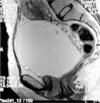Retrorectal tumours: literature review and vilnius university hospital "santariskiu klinikos" experience of 14 cases
- PMID: 21719397
- PMCID: PMC3352196
- DOI: 10.1186/2047-783x-16-5-231
Retrorectal tumours: literature review and vilnius university hospital "santariskiu klinikos" experience of 14 cases
Abstract
Objective: Retrorectal tumours are rare lesions in adults. The diagnosis of retrorectal lesion is often difficult and misdiagnosis is common. We present significant number of cases in view of scarce information available on this matter.
Methods: 14 patients were treated at Vilnius university hospital "Santariskiu klinikos" Centre of abdominal surgery from 1997 to 2010. The case notes of patients who underwent surgery for a retrorectal tumour were reviewed retrospectively. Surgical histories, operations, histological tumour type, surgical time, weight of the specimen, blood loss, length of stay were analysed.
Results: 13 patients underwent laparotomy, 1 patient had combined perineal approach and laparotomy. The most common types of the tumour were fibroma (3 cases), leiomyosarcoma (2 cases). 5 tumours (35,7%) were found to be malignant. 57% of the patients had undergone at least one operation prior to definitive treatment. 5 female patients were initially admitted under gynaecologists. Hospital stay varied from 14 days to 22 days (mean 16.2 days). A report of a representative case is presented.
Conclusions: Retrorectal lesions in female patients can mimic gynaecological pathology. Patients with this rare pathology are to be treated in a major tertiary hospital by surgeons, who are able to operate safely in the retrorectal space.
Figures
References
-
- Spencer RJ, Jackman RJ. Surgical management of precoccygeal cysts. Surg Gynecol Obstet. 1962;115:449–52. - PubMed
Publication types
MeSH terms
LinkOut - more resources
Full Text Sources





